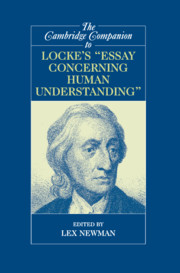Book contents
- Frontmatter
- Introduction
- 1 The Intellectual Setting and Aims of the Essay
- 2 Locke’s Polemic against Nativism
- 3 The Taxonomy of Ideas in Locke’s Essay
- 4 Locke’s Distinctions between Primary and Secondary Qualities
- 5 Power in Locke’s Essay
- 6 Locke on Substance
- 7 Locke on Ideas of Identity and Diversity
- 8 Locke on Ideas and Representation
- 9 Locke on Essences and Classification
- 10 Language, Meaning, and Mind in Locke’s Essay
- 11 Locke on Knowledge
- 12 Locke’s Ontology
- 13 The Moral Epistemology of Locke’s Essay
- 14 Locke on Judgment
- 15 Locke on Faith and Reason
- Bibliography
- Index of Names and Subjects
- Index of Passages Cited
8 - Locke on Ideas and Representation
Published online by Cambridge University Press: 28 July 2007
- Frontmatter
- Introduction
- 1 The Intellectual Setting and Aims of the Essay
- 2 Locke’s Polemic against Nativism
- 3 The Taxonomy of Ideas in Locke’s Essay
- 4 Locke’s Distinctions between Primary and Secondary Qualities
- 5 Power in Locke’s Essay
- 6 Locke on Substance
- 7 Locke on Ideas of Identity and Diversity
- 8 Locke on Ideas and Representation
- 9 Locke on Essences and Classification
- 10 Language, Meaning, and Mind in Locke’s Essay
- 11 Locke on Knowledge
- 12 Locke’s Ontology
- 13 The Moral Epistemology of Locke’s Essay
- 14 Locke on Judgment
- 15 Locke on Faith and Reason
- Bibliography
- Index of Names and Subjects
- Index of Passages Cited
Summary
Locke's Essay is part of the so-called epistemological turn given philosophy by Descartes that assigned fundamental importance to the theory of knowledge. So much is clear from the introduction to Book I: “my Purpose [is] to enquire into the Original, Certainty, and Extent of humane Knowledge; together, with the Grounds and Degrees of Belief, Opinion, and Assent” (E I.i.2: 43). The general aim in the period was to reconcile the startling discrepancy, in all its ramifications, between the so-called manifest image, as it has come to be called, which views the world in the commonsense terms of colors, odors, and tastes, and the emerging scientific image, which sees it in the atomistic (or “corpuscularian”) terms of sizes, shapes, and motion.
Locke's version of the epistemological turn took what his ecclesiastical critic Stillingfleet called the new way of ideas: we perceive things not as they are in themselves, but in terms of our ideas of them. By an idea Locke means the mind's immediate object whenever it thinks, which for him is something in the mind (E I.i.8; II.viii.8). The mind knows the mediate object outside the mind insofar as the idea represents it. The distinction between an idea and its object is Locke's way of dealing with the discrepancy between the manifest and scientific images. So far, all interpretations of Locke are in basic agreement.
- Type
- Chapter
- Information
- Publisher: Cambridge University PressPrint publication year: 2007
- 5
- Cited by



